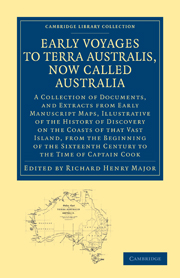 Early Voyages to Terra Australis, Now Called Australia
Early Voyages to Terra Australis, Now Called Australia Book contents
- Frontmatter
- Contents
- INSTRUCTIONS TO THE BINDER
- INTRODUCTION
- A MEMORIAL ADDRESSED TO HIS CATHOLIC MAJESTY PHILIP THE THIRD, KING OF SPAIN
- RELATION OF LUIS VAEZ DE TORRES
- EXTRACT FROM THE BOOK OF DISPATCHES FROM BATAVIA
- THE VOYAGE AND SHIPWRECK OF CAPTAIN FRANCIS PELSART
- VOYAGE OF GERRIT THOMASZ POOL TO THE SOUTH LAND
- ACCOUNT OF THE WRECK OF THE SHIP “DE VERGULDE DRAECK”
- DESCRIPTION OF THE WEST COAST OF THE SOUTH LAND
- EXTRACT TRANSLATED FROM BURGOMASTER WITSEN'S
- ACCOUNT OF THE OBSERVATIONS OF CAPTAIN WILLIAM DAMPIER
- EXTRACT FROM SLOAN MS., 3236
- SOME PARTICULARS RELATING TO THE VOYAGE OF WILLEM DE VLAMINGH
- EXTRACT FROM THE JOURNAL OF A VOYAGE MADE TO THE UNEXPLORED SOUTH LAND
- ACCOUNT OF THE OBSERVATIONS OF CAPTAIN WILLIAM DAMPIER
- A WRITTEN DETAIL OF THE DISCOVERIES AND NOTICEABLE OCCURRENCES
- THE HOUTMAN'S ABROLHOS
- INDEX
- Outline Chart of TERRA AUSTRALIS OF AUSTRALIA
- Plate section
EXTRACT FROM THE BOOK OF DISPATCHES FROM BATAVIA
Published online by Cambridge University Press: 05 February 2013
- Frontmatter
- Contents
- INSTRUCTIONS TO THE BINDER
- INTRODUCTION
- A MEMORIAL ADDRESSED TO HIS CATHOLIC MAJESTY PHILIP THE THIRD, KING OF SPAIN
- RELATION OF LUIS VAEZ DE TORRES
- EXTRACT FROM THE BOOK OF DISPATCHES FROM BATAVIA
- THE VOYAGE AND SHIPWRECK OF CAPTAIN FRANCIS PELSART
- VOYAGE OF GERRIT THOMASZ POOL TO THE SOUTH LAND
- ACCOUNT OF THE WRECK OF THE SHIP “DE VERGULDE DRAECK”
- DESCRIPTION OF THE WEST COAST OF THE SOUTH LAND
- EXTRACT TRANSLATED FROM BURGOMASTER WITSEN'S
- ACCOUNT OF THE OBSERVATIONS OF CAPTAIN WILLIAM DAMPIER
- EXTRACT FROM SLOAN MS., 3236
- SOME PARTICULARS RELATING TO THE VOYAGE OF WILLEM DE VLAMINGH
- EXTRACT FROM THE JOURNAL OF A VOYAGE MADE TO THE UNEXPLORED SOUTH LAND
- ACCOUNT OF THE OBSERVATIONS OF CAPTAIN WILLIAM DAMPIER
- A WRITTEN DETAIL OF THE DISCOVERIES AND NOTICEABLE OCCURRENCES
- THE HOUTMAN'S ABROLHOS
- INDEX
- Outline Chart of TERRA AUSTRALIS OF AUSTRALIA
- Plate section
Summary
Instructions for the commodore, Captain Abel Jansz Tasman, the skipper chief-pilot, Franz Jacobsz Visser, and the counsel of the yachts Limmen and Zeemeuw, and the tender de Brak, destined for a nearer discovery of Nova Guinea, and the unknown coasts of the discovered east and south lands, together with the channels and the islands supposed to be situated between and near them.
The several successive administrations of India, in order to enlarge and extend the trade of the Dutch East India Company, have zealously endeavoured to make an early discovery of the great land of Nova Guinea, and other unknown east and southerly countries, as you know by several discourses, and maps, journals, and papers communicated to you. But hitherto with little success, although several voyages have been undertaken.
1st. By order of the president, John Williamsson Verschoor, who at that time directed the company's trade at Bantam, which was in the year 1606, with the yacht the Duyfhen, who in their passage sailed by the islands Key and Aroum, and discovered the south and west coast of Nova Guinea, for about 220 miles (880) from 5° to 13¾° south latitude: and found this extensive country, for the greatest part desert, but in some places inhabited by wild, cruel, black savages, by whom some of the crew were murdered; for which reason they could not learn anything of the land or waters, as had been desired of them, and, by want of provisions and other necessaries, they were obliged to leave the discovery unfinished: the furthest point of the land was called in their map Cape Keer-Weer, situated in 13¾° S.
- Type
- Chapter
- Information
- Early Voyages to Terra Australis, Now Called AustraliaA Collection of Documents, and Extracts from Early Manuscript Maps, Illustrative of the History of Discovery on the Coasts of that Vast Island, from the Beginning of the Sixteenth Century, pp. 43 - 58Publisher: Cambridge University PressPrint publication year: 2010First published in: 1859


